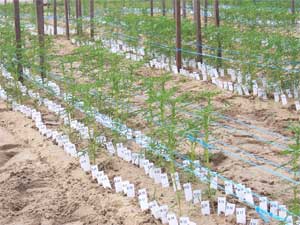South Perth, Western Australia
October 17, 2012
Western Australian scientists are at the cutting edge in marker development for molecular plant breeding by rapidly identifying nearly 40 markers in one go.
The team led by Department of Agriculture and Food (DAFWA) scientist Dr Hua’an Yang is the first to devise a new methodology which integrates next-generation sequencing (NGS) technology into marker development protocol to produce large numbers of markers to track agronomic genes.

Plants containing desirable genes identified by molecular markers are selected and kept for breeders. The work is recognised to have ‘revolutionised’ the Australian lupin breeding program.
Department Grains Industry Executive Director Peter Metcalfe said the ability to rapidly identify markers was a huge step forward in molecular plant breeding, improving efficiency and cost effectiveness.
“Identifying key markers for target traits quickly will significantly assist the grains industry and plant breeders to develop new varieties that are suitable for our climatic conditions as well as meet the needs of our end users,” Mr Metcalfe said.
Department senior research officer Hua’an Yang said many scientists were using NGS in plant research, but his team had gone further to use the technology to successfully identify marker development in practical breeding.
“Our new approach is designed for rapid marker discovery for major genes, which complements the department’s NGS-based mapping strategy for multiple gene controlled quantitative traits,” Dr Yang said.
“The department’s lupin marker team has an excellent track record in science innovation. To date, 100 per cent of molecular markers used in lupin breeding have been produced by the department.
“In the past 10 years, the department has created and conducted the only Australian example in large-scale implementation of molecular markers on pulse breeding programs.
“We are very confident we will continue to deliver outstanding benefits for the Australian pulse industry to achieve accelerated genetic improvements.”
This research was funded by Department of Agriculture and Food Western Australia, Beijing Genome Institute and the Grains Research and Development Corporation.
Dr Yang’s scientific paper ‘Application of next-generation sequencing for rapid marker development in molecular plant breeding: a case study on anthracnose disease resistance in Lupinus angustifolius L’ is available at biomedcentral.com.